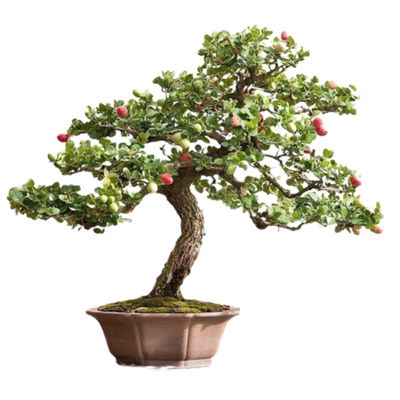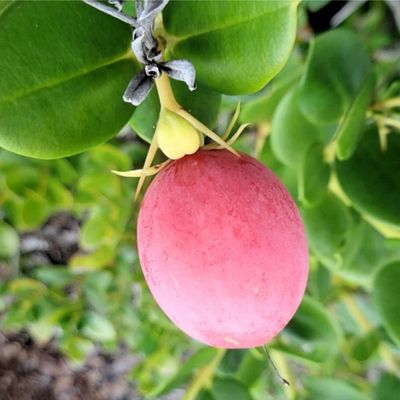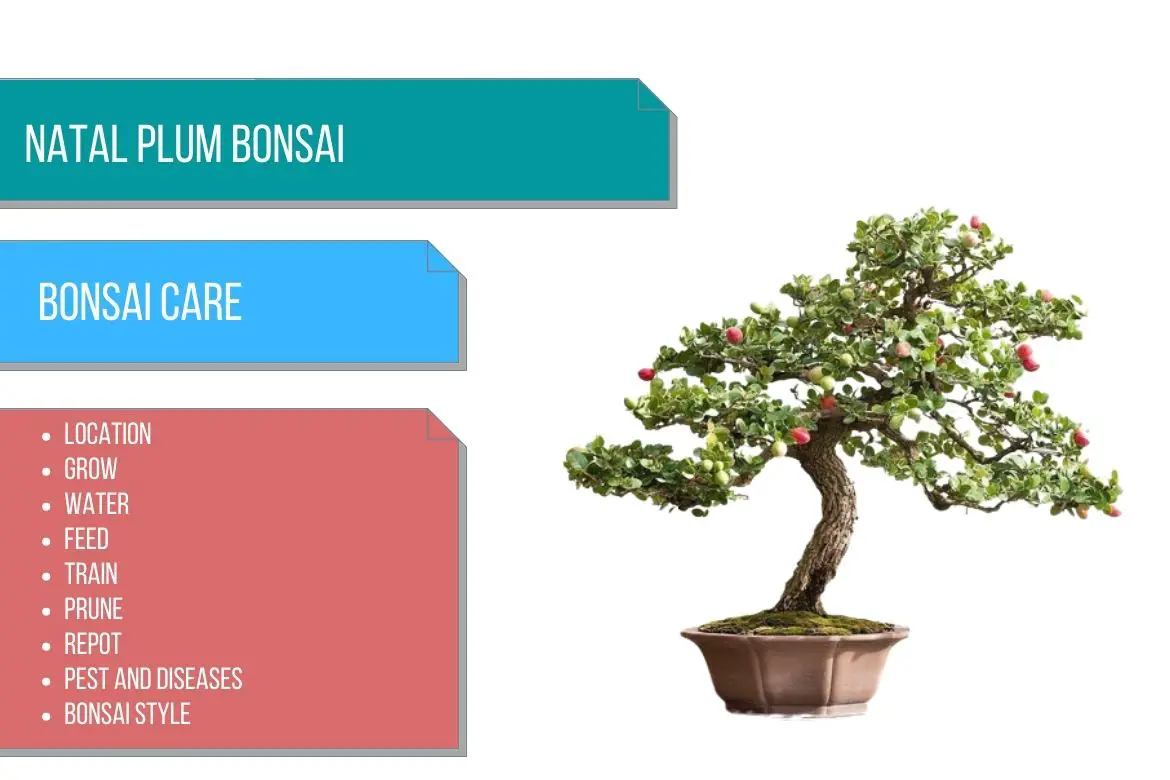
Natal Plum
(Carissa macrocarpa)
Country of Origin : South Africa
Bonsai Styles : Informal upright, cascade
Zone : 9 – 11
Commonly grown as an ornamental, the natal plum bonsai is one of the easiest bonsai trees to grow and doesn’t require a lot of maintenance. Hence, it is a wise pick for bonsai beginners.
The Carissa macrocarpa (earlier known as Carissa grandiflora) plant is a fast-growing shrub. In addition to being drought-resistant, it likes high humidity levels and heat.
This plant has tough evergreen oval leaves that are small and glossy rich dark green in color.
The dark brown fissured bark is one of the key features of this bonsai tree.
There are star-shaped fragrant white flowers on this shrub, as well as a purple plum-like fruit that is often eaten raw by people in its native – South Africa.
The clusters of white flowers bloom in May. This is followed by scarlet berries in the month of July.
One of the reasons that the Natal plum is so popular as a hedge plant could be because it has sharp thorns that can reach a length of half an inch.

Natal plum bonsai flower

Natal plum bonsai berry
Best location to keep Natal Plum Bonsai
There should be at least 4 hours of direct sunlight per day for the Natal plum bonsai tree in order to thrive.
Natal plum bonsai is also a very good choice for indoor bonsai tree.
The bonsai should be placed in southern or western windows or supplemented with grow lights if it are to be grown indoors.
For the growing season, an average temperature range of 70°F to 85°F (21°C to 30°C) is recommended.
The bonsai tree will prefer being indoors in cool winter. A good temperature range to maintain at that time can be 55°F to 65°F (12°C to 18°C).
During the summer months, you can keep the Natal plum bonsai outdoors, and then move the bonsai pot back inside when the temperature reaches down to 50°F to 55°F (10°C to 12°C).
IMP: Refer sunlight requirements for indoor plants for more indoor gardening ideas. Also, refer to do bonsai trees need sunlight for more indoor and outdoor bonsai location ideas.
Propagation of Natal Plum
It is possible to grow natal plum from seed very easily.
The seeds germinate within 2-4 weeks of planting and grow into a new plant in a few weeks time.
Cuttings of the Natal plum can also be used to propagate the plant.
There is, however, a good chance of success only if the cuttings are lignified. (woody stems)
It is best to choose cuttings that are 4 to 6 inches in length, treat them with rooting hormone, and either place them in moist sand or in a glass of water to begin the rooting process.
Plant the stem in a bonsai medium once the roots appear.
Watering Natal Plum Bonsai
Even though natal plum plant is drought resistant, when grown in bonsai container, a decent watering routine is always good for the plant.
It is important to water your Carissa macrocarpa bonsai tree often, but you should let the soil dry slightly between watering in order to prevent root rot.
As stated earlier, the plant loves high humidity. You can spray some mist on the foliage of the bonsai everyday.
Read watering bonsai tree for more details.
Wiring Natal Plum Bonsai
As the branches of the natal plums are flexible, wiring them should be relatively straightforward.
It is possible to wire and bend even moderately large trunks, up to about three-quarters of an inch in diameter, to give them the desired shape that the user desires.
Pruning Natal Plum Bonsai
When to prune Natal Plum bonsai?
How to prune Natal Plum bonsai?
Pruning is possible whenever the bonsai tree is in active growth. The best time to do major pruning is in mid to late spring, after the flowers have bloomed.
While pruning, it is important to be mindful of the thorns.
During the growing season, the Natal plum may become a bit leggy, but if pruned back hard – vigorous growth will again start.
The blooms appear on the new growth in the middle of the summer to the end of the summer.
Make sure you remove the flowers from young natal plum bonsai tree. As the flowers absorb a lot of energy from the tree, the young trees end up having a very slow growth.
Removing the flowers will promote relatively faster growth of the branches and foliage.
As the tree matures, you can stop removing the flowers.
It is important that you do not remove all the green foliage from a branch. Doing so will result in the branch dying off.
Repotting Natal Plum Bonsai
When to repot Natal Plum bonsai?
Repot natal plum bonsai tree in early summer every 2nd year. Pinch out the tips of young shoots.
Repotting will also depend on how much pot bound your trees roots are.
You can also perform some root pruning. Do not prune woody mature roots unless you absolutely have to.
Keep the bonsai container in a warm place.
A sandy alkaline soil is the ideal soil for the Natal plum.
You can use a basic free-draining alkaline bonsai soil mix as a potting soil.
Must Read: Bonsai Soil Recipes
Must read : Choosing the right bonsai container
Feeding Natal Plum Bonsai
A balanced fertilizer should be applied on a weekly basis at half strength.
During the winter, you should reduce the frequency of feed applications to once every 2 to 3 weeks.
Read more about bonsai fertilizer and its application.
Diseases and pest of Natal Plum Bonsai
Generally pest free. However, sometimes this plant can be attacked by scale insects (Chrysomphalus aonidum), aphids and mealybugs (Pink hibiscus mealybug).
You can remove these manually or by jet of water. You can also wet the foliage with horticultural soap as an alternative treatment. 5 tablespoons of 2% horticultural oil mixed with one gallon of water can be applied to control the insects.
Pink hibiscus mealybug will cause curling of leaves. The plant growth will also be stunted. Systemic insecticides like imidacloprid or dinotefuran can be applied to control them. Or if you see just a few of them, then apply some alcohol on the effected leaf using a q-tip.
In case the bonsai soil is not aerated enough or doesn’t drain properly, the tree can also suffer from leaf spot.
Just remove the effected foliage and everything will be fine.
Natal Plum bonsai care
In cold weather conditions, it is possible for the leaves of the Natal plum to fall off. So dont worry, these leaves will grow back once the temperature rise.
Natal plum is highly susceptible to root rot. So make sure you never over water the natal plum bonsai tree.
In order to maintain humidity when growing natal plum bonsai indoors, it is recommended to keep the pot on a tray filled with water, while positioning the pot on pebbles in order to keep it elevated and to keep the roots from sitting in water at any point in time.
Fun fact : Natal plum berries are delicious and taste pretty much like cranberries. You can also make jam out of them.

